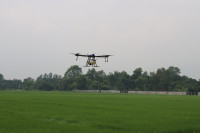Sudurpaschim Province
Lack of animal rescue centre hinders wildlife control operations
There have been incidents where captured wild animals have died due to the absence of a skilled rescue team and a proper infirmary in Kanchanpur.
Bhawani Bhatta
Forty-two years old Ganga Devi Chand of Panchauri in Belauri Municipality was fatally attacked by a tiger 14 km from Shuklaphanta National Park last Friday. Park officials could not conduct immediate rescue since the tiger was still around. The national park officials had to wait for a technical team from the Bardiya National Park to arrive to capture the tiger.
On Saturday morning, a joint team from the Bardiya National Park and the National Trust for Nature Conservation (NTNC) from the Shuklaphanta conservation programme conducted the operation to capture the man-eater. It was several hours before the big cat was tranquilised and captured, and much later when a search was conducted for Chand. Her body was recovered near the incident site.
According to the officials of Shuklaphanta National Park, the tiger is a five-year-old female who had been occasionally spotted in areas adjoining human settlements.
Lakshmiraj Joshi, head of the Shuklaphanta conservation programme under the NTNC, said it took the team nearly 22 hours to capture the tiger and hence Chand could not be rescued on time. “This time we had enough manpower to run both the operations—capturing the tiger and rescuing the victim—but we didn’t have the necessary tools and equipment needed to conduct the operations,” said Joshi. “We had to wait for a support team from the Bardiya National Park to arrive. We lost precious hours waiting for their arrival.”
The national park does not have the essential tools such as tranquillisers and darts, and drugs and medicines needed for wildlife control operations. “This is the first time the NTNC team has captured a tiger, and that too with the help of Bardiya National Park’s team,” said Joshi. “If our team had the equipment, the tiger could have been captured immediately after the incident and maybe we would have been able to save the victim too.”
The lack of rescue centres in Shuklaphanta also makes wildlife control operations difficult, says Joshi. “Capturing a wild animal is only the first step. The most important part is keeping the captured animal in a safe place. We don’t have rescue centres here for the rehabilitation and treatment of animals involved in attacking humans,” he said. “There have been incidents where captured wild animals have died due to the absence of a skilled rescue team and a proper infirmary.”
According to Roshan Singh Thagunna, assistant conservation officer at the Suklaphanta National Park, the tiger captured on Saturday was transferred to the Central Zoo in Lalitpur for lack of a rescue centre locally. “Transferring a wild animal is a costly operation. Besides, the medical team has to use heavy dosages of drugs to keep the animal unconscious during the journey and this increases the risk of the animal dying,” said Thagunna.
Two leopards died last year in Kanchanpur and Baitadi in the absence of a rescue centre where they could be treated for their wounds. “A leopard got caught in a trap in Bhimdatta Municipality in Kanchanpur and was rescued by the authorities. But the leopard died the next day,” said Thagunna. “In Baitadi too, a leopard fell into a trap and died before it could be rescued and treated for injuries. If we had a wildlife rescue centre locally, these animals could have been saved.”
Ved Kumar Dhakal, secretary of the Ministry of Industry, Tourism, Forests and Environment of the Sudurpaschim province, says talks are ongoing to build a rescue centre or a zoo in Attariya of Kailali district so that such rescued animals could be kept there. “If we have such a facility then the rescued animals can be kept in those centres or zoos. They needn’t be transported anywhere else. We are working out a plan to set up either a rescue centre or a zoo in Kailali,” he said.
According to the data from the Shuklaphanta National Park, the number of tigers in the park has been increasing every year. Currently there are 36 tigers in the park.




 5.44°C Kathmandu
5.44°C Kathmandu













